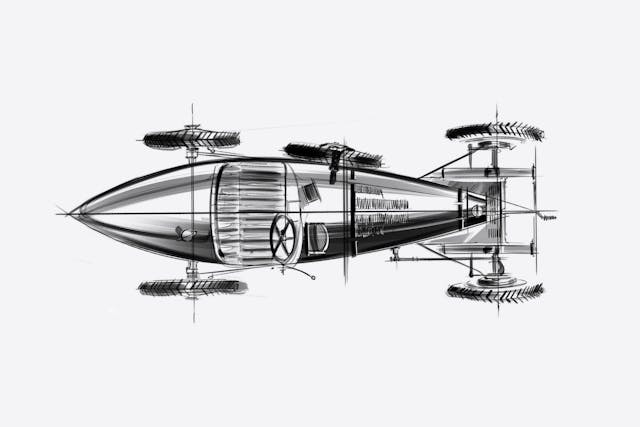Media | Articles
Peak French: The Bugatti Type 35
Earlier this summer, we celebrated Bastille Night at the Hagerty U.K. Clubhouse at former RAF bomber base Bicester Heritage. We packed the Clubhouse with French cars and their owners, and I was joined on stage by our own Adam Sloman and compère, TV presenter Paul Cowland.
Our job was to explain what we thought the best French car of all time was. It’s a big call, as there are some strong contenders. We discussed the Citroën 2CV and DS, the Renault 5 Turbo, and the Alpine A110. Adam suggested it was the Peugeot 205—the first truly modern hot hatch—but I went slightly older. One hundred years older, in fact. For me, the best French car of all time is the Bugatti Type 35.

On August 3, 1924, Bugatti rolled out five examples of its new racing car for the French Grand Prix at Lyon. Ettore Bugatti also drove a sixth replacement car 500 kilometers from the Bugatti factory at Molsheim to test its endurance. This new Type 35 model drew a huge amount of attention and started well, taking the fastest lap, but soon the specially made tires started to delaminate, and the best finish in the model was by Jean Chassagne, who took seventh place. Despite its inauspicious start, the potential of the car was obvious, and before long the order book started to fill up. Over the next six years, the engine was expanded from 2 liters to 2.3, a Roots-type three-lobe supercharger was offered, and the body and drivetrain were almost constantly tweaked, which kept the Type 35 competitive.
Actually, “competitive” is a huge understatement. The model dominated its class, winning track races, hill climbs, and the epic road races of the era. A Type 35 won the Targa Florio for five consecutive years starting in 1925, another won the notorious Eifelrennen at the Nürburgring in 1930, and almost every European grand prix fell to the car. They’re successful in historic racing to this day.

But for me, it’s not just the racing history or the sheer beauty of the Type 35 that make it so special—it’s the engineering. Ettore Bugatti wasn’t just an aesthete but also a passionate race engineer, and the Type 35’s dominance was based on some extraordinary design elements. Decades before Colin Chapman “added lightness” to his Lotus cars, Bugatti kept unsprung weight low with hollow axles, quarter-elliptical leaf springs, and paring the alloy bodywork—removable in under an hour—to a minimum. Crossmembers, like the one that bonds the four-speed crash gearbox to the chassis, were made from tubes with their ends splayed for strength and lightness. The wheels—finned aluminum with inbuilt brake drums and bolted rims to stop the tires from rubbing off during fast cornering—were a total revelation, and the fins were even angled to enhance air flow. Do you have alloy wheels on your car? The Type 35’s “turbofans” are the reason why.
Marketplace
Buy and sell classics with confidence

This is the crux: The Type 35 not only influenced the design of every other racing car of the era but, like any groundbreaking sports car, it introduced elements that found their way into road cars and were later adopted as standard.
The historical significance of the Bugatti Type 35 translates to the collector car market as well. Today, all versions of the Type 35 (and its later offshoots the 37 and 39) are sought after by collectors, and they seldom come to market. There is even a sizable market for Type 35 replicas, including the top-quality recreations by the Argentine company Pur Sang that themselves sell for six-figure prices.
Production numbered several hundred examples but, race cars being race cars, most Type 35s have been bent, fixed, and had new engines and bodies fitted over the years. Originality—or at least a very comprehensive paper trail—is key. Race history is also critical, and a car that has factory race wins is highly prized, as proven by the sale in 2021 of a 1929 Type 35B. The car won both the 1929 French and Spanish Grands Prix and retained a matching-numbers engine; it sold well over the top $4.5M estimate for $5.615M. The same car had previously sold at Monterey in 1996 for $560,000 which, despite the fact that it had been fully restored by specialist Ivan Dutton in the intervening time, is a significant uplift.
The variables of race history, configuration, originality and the use of replacement components mean that Type 35s have a wide range of prices. On the somewhat rare occasion that one does come to market, its value can range from anywhere in the mid-six figure range up to the $5M-plus figure noted above. Expensive, yes, but that’s what it takes to buy the best French car of them all.















No contest the only good French car was designed by an Italian.
Funny enough I have a soft spot for the EB110 SS. The Italian Bugatti.
Everyone has an “If I won the lottery list,” and there are three cars on mine: a Type 35, a 275 GT Ferrari, and a 427 485hp side-oiler Cobra (I’ve actually ridden in one of those!)
Bugattis are generally beautiful, fast, and way ahead of their time, and clearly their contribution to ‘improving the breed’ is formidable. I’m just not sure how much use I’d get from such a car, myself. I did have one ride in a Type 35, years ago, at Monterey, and it was pretty thrilling, so maybe I could get used to it. Hmmm.
I’ve been in love with the Type 35 since building a Revell model of one as a kid. It’s on my bucket list, too (which is why I expect to be on this side of g-d’s Green Earth for some time, yet).